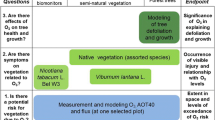Abstract
Lower atmospheric ozone, a gaseous air pollutant, is toxic to many plants and threatens the health of forests across the United States. In the 1990s, the USDA Forest Service began a monitoring program to assess status and trends with respect to the presence of phytotoxic concentrations of ozone in our nation’s forests. Ozone detection is based on the foliar (leaf) injury response of ozone-sensitive bioindicator species; a response that is conditioned primarily by the levels of ozone in the air and moisture in the soil. One goal of the program is to use the injury data in conjunction with ozone exposure and plant/soil moisture indices to develop a quantitative assessment of the effects of ozone pollution on plant life across the country. Preliminary work found that a logistic regression model was inadequate to describe the relationship between ozone injury and the environmental factors. Hoping for a better fit, we applied a generalized additive model. We refined the model by using different categorization methods for foliar injury and by incorporating different geographic and ecological factors. Finally, we concluded that our refined model, when compared to the logistic model, explains the data better and provides a better description of the relationship of interest.
Similar content being viewed by others
References
Coulston JW (2011) Modeling ozone bioindicator injury with microscale and landscape-scale explanatory variables: a logistic regression approach. In: Conkling BL (ed) Forest health monitoring: 2007 national technical report, Gen. Tech. Rep. SRS-147. U.S. Department of Agriculture Forest Service, Southern Research Station, Asheville, NC
Davis DD, Orendovici T (2006) Incidence of ozone symptoms on vegetation within a national wildlife refuge in new jersey, usa. Environ Pollut 143: 555–564
FIA (2006) FIA field methods for phase 3 measurements. USDA forest service http://www.fia.fs.fed.us/—click on FIA Library—Field Guides, Methods, and Procedures—Ozone Bioindicator Plants. http://www.fia.fs.fed.us/
Karnosky DF, Skelly JM, Percy KE, Chappelka AH (2007) Perspectives regarding 50 years of research on effects of tropospheric ozone air pollution on us forests. Environ Pollut 147(3):489–506 doi:10.1016/j.envpol.2006.08.043. http://www.sciencedirect.com/science/article/B6VB5-4M7VFN3-2/2/5a6486187067d6c6b78b56d68409dc44. (Air pollution and climate change: a global overview of the effects on forest vegetation)
Kohut R (2007) Assessing the risk of foliar injury from ozone on vegetation in parks in the U.S. national park service’s vital signs network. Environ Pollut 149(3):348–357 doi:10.1016/j.envpol.2007.04.022. http://www.sciencedirect.com/science/article/B6VB5-4P7FHT7-1/2/f8e9b2605826763c6f46c353dcc6f61e. (Air pollution and vegetation effects research in national parks and natural areas: implications for science, policy and management)
Manning WJ (2003) Detecting plant effects is necessary to give biological significance to ambient ozone monitoring data and predictive ozone standards. Environ Pollut 126(3):375–379 doi:10.1016/S0269-7491(03)00240-9.http://www.sciencedirect.com/science/article/B6VB5-498TX2X-/2/b9add77b7cfe54f34ab94e6e6b1bed0d
McNab W, Cleland D, Freeouf J, Keys Jr J, Nowacki GJ, Carpenter C (2005) Description of ecological subregions: sections of the conterminous United States. U.S. Department of Agriculture, Forest Service, Washington D.C. CD-ROM
PDSI (2007) Palmer drought indices. US Department of Commerce, National Climate Data Center, Climate Monitoring, Drought Monitoring, http://www.ncdc.noaa.gov/oa/climate/research/prelim/drought/palmer.html
Percy K, Legge A, Krupa S (2003) Tropospheric ozone: a continuing threat to global forests? In: Karnosky D, Percy KE, Chappelka AH, Simpson C, Pikkarainen J (eds) Air pollution, global change and forests in the new millenium, developments in environmental sciences, vol 3, pp 85–118. Elsevier doi:10.1016/S1474-8177(03)03004-3.http://www.sciencedirect.com/science/article/B7W55-4HRP40V-6/2/2edd5bd14be488848e84aa0f2052e32e
Rose AK, Coulston JW (2009) Ozone injury across the southern United States, 2002–2006. Tech. Rep. Gen. Tech. Rep. SRS118, Asheville, NC: U.S. Department of Agriculture Forest Service, Southern Research Station
Smith GC, Coulston JW, O’Connell BM (2008) Ozone bioindicators and forest health: A guide to the evaluation, analysis, and interpretation of the ozone injury data in the forest inventory and analysis program. Tech. Rep. General Technical Report NRS-34, United States Department of Agriculture
Smith GC, Smith WD, Coulston JW (2007) Ozone biomonitoring sampling and estimation. Tech. Rep. Gen. Tech. Rep. NRS-20, U.S. Department of Agriculture, Forest Service, Northern Research Station, Newtown Square, PA
Woodhall CW, Conkling BL, Coulston JW, Jovan S, Perry CH, Schulz B, Smith GC, Will-Wolf S (2010) The forest inventory and analysis database version 4.0: database description and users manual for phase 3. General Technical Report NRS-61, U.S. Department of Agriculture, Forest Service, Northern Research Station, Newtown Square, PA
Author information
Authors and Affiliations
Corresponding author
Rights and permissions
About this article
Cite this article
Wang, P., Baines, A., Lavine, M. et al. Modelling ozone injury to U.S. forests. Environ Ecol Stat 19, 461–472 (2012). https://doi.org/10.1007/s10651-012-0195-2
Received:
Revised:
Published:
Issue Date:
DOI: https://doi.org/10.1007/s10651-012-0195-2




